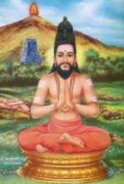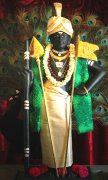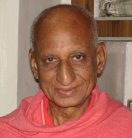

THE ESOTERIC
KANDAR ANUBHUTI
OR
THE SECRET TEACHING ON
GOD-EXPERIENCE
(A Treatise on Adwaitic Realization)
OF
SAINT ARUNAGIRINATHAR

 |  THE ESOTERIC KANDAR ANUBHUTI OR THE SECRET TEACHING ON GOD-EXPERIENCE (A Treatise on Adwaitic Realization) OF SAINT ARUNAGIRINATHAR |  |
 | by N.V. Karthikeyan |  |
| verses contents 34 35 36 37 38 39 40 41 42 43 .. 49 this verse in PDF version (4 parts) p-1 p-2 p-3 p-4 complete download of this book |
VERSE-39 மாவேழ் சனனம்கெட மாயைவிடா மூவேடணை என்று முடிந்திடுமோ கோவே குறமின்கொடி தோள்புணரும் தேவே சிவசங்கர தேசிகனே.Maa-vezh sananam keda maayai vidaa, Moo-vedanai enru mudinthidumo Kove kuramin-kodi thol punarum, Theve sivasankara thesikane. For the seven great births to come to a close, Commentary Having equipped himself with all that is necessary for a leap into the Absolute, the seeker now aspires to realise God at the earliest. He embarks on his Sadhana, as instructed by his Guru, with a resolute and all-out effort to break the bonds of the causal chain and experience God. As the aspiration wells up in his heart, he first offers a prayer to the Lord (Bhakti) in this verse before he starts his uninterrupted meditation on the Absolute (Jnana) in the next verse. Bhakti and Jnana go hand in hand from the very beginning and gradually they get merged into one another. He prays: "O Lord! Who embraced the lightning-like huntress (Valli Devi)! O Guru of Sivasankara! When will the three Eshanas (basic cravings), which are inseparable from Maya, come to an end, so that I will be free from the seven great kinds of births?" This Maya is mysterious and indescribable. On the one side it is inseparable from the basic desires (Eshanas) in the individual, forcing him to perform desire-motivated Karmas, and on the other side it provides the field of this phenomenal universe to work out those Karmas in the seven great (categories) species of births into which the individual souls are born. This field of the phenomenal universe is termed as 'house' in the next verse, in which the deluded souls keep roaming. The three Eshanas or basic cravings are desire for wealth/property/possessions, desire for family and children, and desire for name and fame in this world and joys of the heavens. These are inseparable from the causal body which is Avidya or Ariyamai or Ignorance or Maya. They are the cause of births in the seven kinds of Yonis or species -- gods, humans, animals, birds, insects, aquatics and plants, -- which are part of the phenomenal universe, the 'house' of Maya. Hence the prayer for their total destruction. This verse can be said to be a more detailed exposition of verse-16. 'Peraasai' of verse-16 is the 'three Eshanas' here, and 'uzhaluthal' there is 'Maavezh sananam' here. (This has also reference to verse-35: Vidhikaanum ...). Family and home have been renounced. Sannyasa has been taken. Mahavakya Upadesa has been obtained (verse 37). Only the last vesture of Maya in its causal form, i.e., the condition where the three Eshanas are inseparable from it, remains to be rent asunder. The Sadhaka is now pining to get rid of this also. This extreme longing to be freed from Samsara is a precursor to the final stroke of Sadhana which he is to undertake (as would be seen in the next verse), before which he offers an invoking prayer to the Lord to take him into his possession, even as He embraced Valli, accepted her and made her His own. The cycle of birth and death is endless. The Jiva (soul) goes on taking birth after birth in different species, according to its desires and Karmas, and this cycle never ceases until it is totally free from all desires. It is said that there are 84 lakh (Yonis) species, and the soul finally attains a human birth, which is the door-way to salvation. Though there are 84 lakh Yonis (species), they are brought under seven categories viz., plants, aquatic creatures, reptiles, birds, animals, human beings, and Devas (gods). These seven kinds of birth or Yonis are referred to as "great," because in each kind there is innumerable variety or variation. The 84 lakh Yonis are said to be distributed among these seven as follows: 1. Devas: 14 lakh Yonis, 2. Human beings: 9 lakhs, 3. Animals: 10 lakhs, 4. Birds: 10 lakhs, 5. Reptiles: 11 lakhs, 6. Aquatic creatures: 10 lakhs, and 7. Plants: 20 lakhs. These seven great births are within the domain of Maya. If one is to be free from births and deaths, the three Eshanas should cease. The three Eshanas constitute the essence of Maya; they are so inseparable from Maya that they are themselves verily Maya. To be free from the Eshanas is to be free from Maya. Eshana means desire. It is not desire in its gross form for this or that object, but is the basic craving or urge of the soul for externalisation. Though desires are countless in number, they are boiled down to basically three. These three Eshanas are the cause for the birth of the Jiva in the different wombs - the seven great births. Unless these desires are given up, there is no scope for freedom from birth and death. The three Eshanas are: (1) Arthaishana or Vittaishana, (2) Putraishana or Daaraishana, and (3) Lokaishana. (1) Arthaishana is the desire for wealth, property, etc. One thinks that if he possesses great wealth, he can command all things and enjoy life in its full measure. So, people crave for riches. (2) Putraishana is the desire for wife and children, particularly males. It is desire for happiness here and hereafter. (3) Lokaishana is the desire for name and fame in the world, and also for the joys of the heavens. One wishes to be the most prominent person in his place (country), in his field of activity (art, games, etc.) and even in the religious and spiritual fields - one wishes to be widely known and revered. In short, wherever one is or whatever one does or however one is, one wishes to be prominent and well-known. In the Tamil language the three Eshanas are known as: மண்ணாசை, பெண்ணாசை and பொன்னாசை. These Eshanas are the obstacles for the attainment of liberation, though they may bring happiness here and take one to heaven, etc. They may be called the knots of the heart, the root of Samsara, most difficult to be broken. They limit the consciousness, which is otherwise universal, to a particular body or realm of experience. But for the desires, who would not attain liberation? While, thus, the desires are the direct obstacles to Anubhuti - Realization or experience of the Absolute - Lord's Grace is the direct means to attain Anubhuti. The seeker, therefore, invokes the grace of the Lord, for an early destruction of the three Eshanas, addressing Him in three ways as, "O King of the Universe," "O Lord who embraced Valli Devi," and "O Guru of Sivasankara." If the citizens of a country have any problem, they have naturally to approach the king of that country for their redress. Even so, the seeker resorts to the Lord, who is the "King of the Universe," for the removal of the Eshanas. Lord Skanda went to the fields where Valli Devi was, embraced her, and finally accepted her as His Consort, by which He released her, forever, from the control of the cruel hunters. Similarly, if the Lord's grace envelops the Jiva, the latter can be freed from the grip of the Eshanas. Hence, he invokes the Lord's grace by addressing Him as the "Embracer of the lightning-like hunter-fostered Valli Devi." Again, when Guru's grace comes in its full measure, one's true identity with the Lord is firmly established. Therefore, the Lord is referred to as "the Guru Supreme of Lord Siva." In the beginning of Sadhana, Maya troubles the seeker in the form of gross, individual objects such as wife, children, wealth, etc. - as the many things external to him. This was the condition portrayed in verse 5, where the Sadhaka is in the beginning stages of his journey to the Immortal. But, after due initiation by the Guru into the techniques of meditation and after having a glimpse of Cosmic Consciousness, Maya becomes an indescribable one, "Illeyenum Mayai" - Maya which is said to be non-existent. Though it is experienced as the visible world, it is nullified in the cosmic awareness; and yet, one has to live in and experience it, though with a transformed vision, which gives him the conviction that it is, after all, perishable - "Padu Mayai." Then, it is not the individual objects outside but the world as such that is Maya. By world, one's own body is also included which is also nullified in meditation, though experienced at other times. But in this verse, Maya extends to the whole of creation, i.e., the seven kinds of birth into which are distributed the 84 lakh Yonis, which are only heard of but not visible - yet located in the heart as the Eshanas (basic cravings). How strange is this Maya! In its grossest form, Maya is regarded as the isolated objects and also external to the seeker - limited and away. In its subtle form, from individual objects it extends to the world on the one side, and on the other from external objects it reaches his own body - more extensive and closer. In its causal form, from the objects and world, it extends to the whole of creation on the one side, while it recedes within the seeker himself and lodges itself as the Eshanas in his heart - most extensive and closest. This is the mystery of Maya. Hence, though rejection of external objects (gross condition) is good, this alone will not do. Though negation of the world and body in meditation is higher (subtle condition), this is also not enough. The seven great births have to cease by the destruction of the heart's cravings or Eshanas (causal state), if liberation is to be attained. How pithily does Arunagirinathar convey subtle secrets! A doubt may arise that the 3 Eshanas have already been given up at the time of taking Sannyasa. Why then does he now seek to destroy them again? The 3 Eshanas renounced at Sannyasa are the gross and subtle forms of desires. What is sought to be destroyed now is the causal condition of the Eshanas, in which condition even the 3 Eshanas are themselves not distinguishable one from the other, and also they are identical with, inseparable and indistinguishable from Maya. If the causal condition of the three Eshanas (which is identical with Maya) were to be destroyed on taking Sannyasa itself, then the disciple would have attained God-realisation then and there, and there would have been no need for the Guru to instruct him to do meditation on 'Aham Brahma Asmi' and destroy ego to its root, i.e., Avidya (Verse-37) or the causal condition of Maya. The three Eshanas, which are inseparable from Maya, referred to in this verse denote their causal condition, for it is the cause of "seven great births." This causal condition of Maya may be said to be the "Mahamaya", which the Lord alone is capable of destroying, (Mahamaayai kalainthida valla Piraan) mentioned in the earlier part of verse 5. This causal condition is to be differentiated from the "Jaganmaya" constituted of "home, wealth and women" (Ahamaadi Madanthaiyar) referred to in the latter part of verse 5, which is its gross condition; as also from the "Illeyenum Mayai" (verse 29) and the "Padu Mayai" (verse 31), which are its subtle conditions. And the aspirant acutely longs for the grace of the Lord for the removal of the Mahamaya or the causal condition of the three Eshanas. The desperate cry of the soul which longs for a final release from the grip of the three Eshanas is echoed in this verse. A close and deep study of the verse would seem to reveal the following secret: "My soul is gripped by the three Eshanas. As you embraced Valli, if You, O Lord, come and embrace my soul, only then can I be freed from the grip of the Eshanas and be liberated from births and deaths. O Lord, when shall You be pleased to do this? There is no other means. So, pray condescend to do soon." The Lord's Maya, which is constituted of the three Eshanas and which scorches the Jiva in the seven kinds of births, can be overcome by the Lord's grace only. "Verily, this divine illusion of Mine (Maya), made up of the (three) qualities (of nature) is difficult to cross over; those who take refuge in Me alone, cross over this illusion," says Lord Krishna in the Bhagavad Gita (VII-14). |
| contents 34 35 36 37 38 39 40 41 42 43 .. 49 this verse in PDF version (4 parts) p-1 p-2 p-3 p-4 |
| ... www.kaumaram.com ... The website for Lord Murugan and His Devotees முகப்பு கௌமாரம் அட்டவணை மேலே தேடல் home Kaumaram contents top search |
If you do not see Tamil characters or for 'offline' viewing, please install 'SaiIndira' fonts from Azhagi.com download Free Azhagi software |
Kaumaram.com is a non-commercial website. This website is a dedication of Love for Lord Murugan. Please take note that Kaumaram.com DOES NOT solicit any funding, DIRECTLY or INDIRECTLY. [xhtml] .[css] |